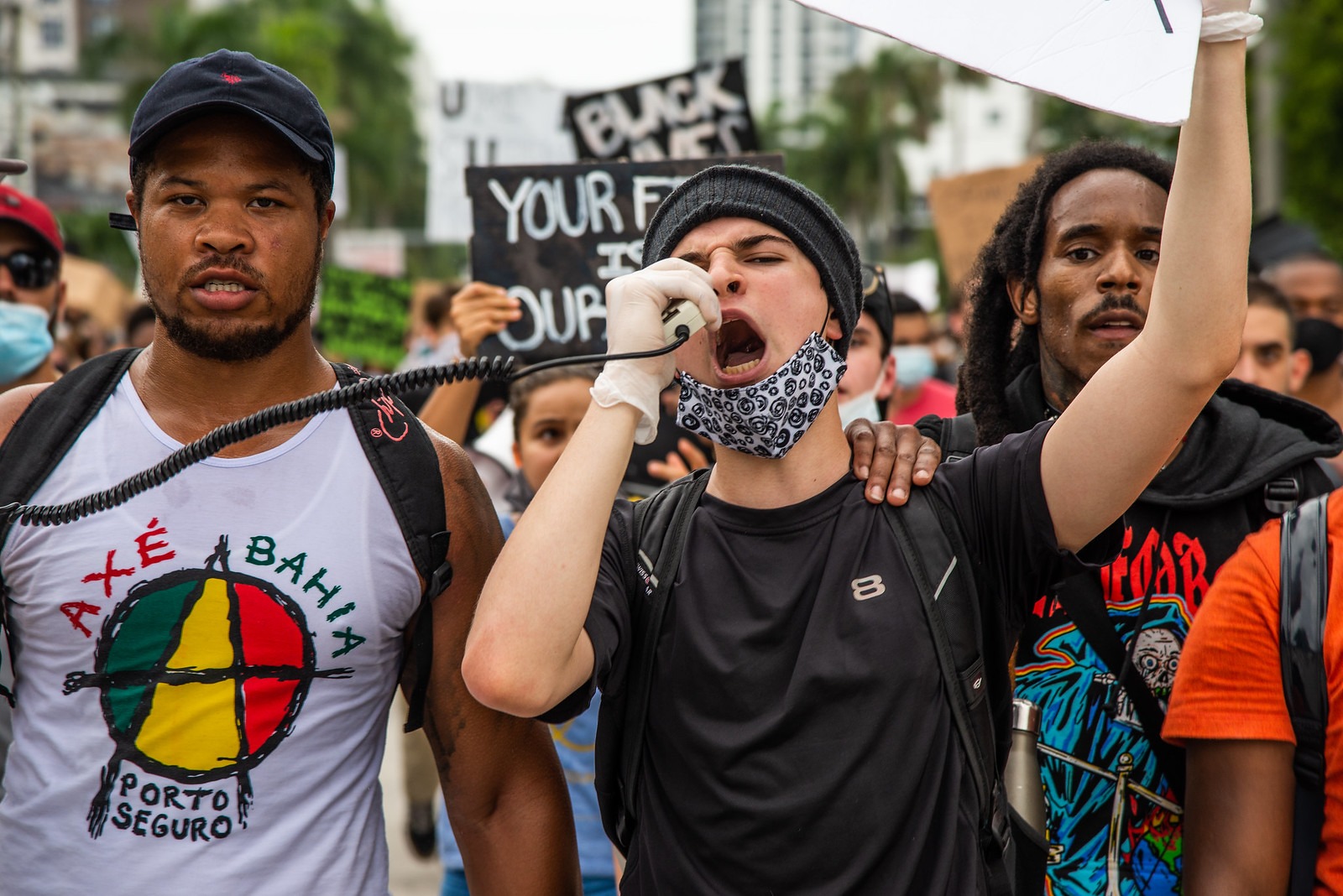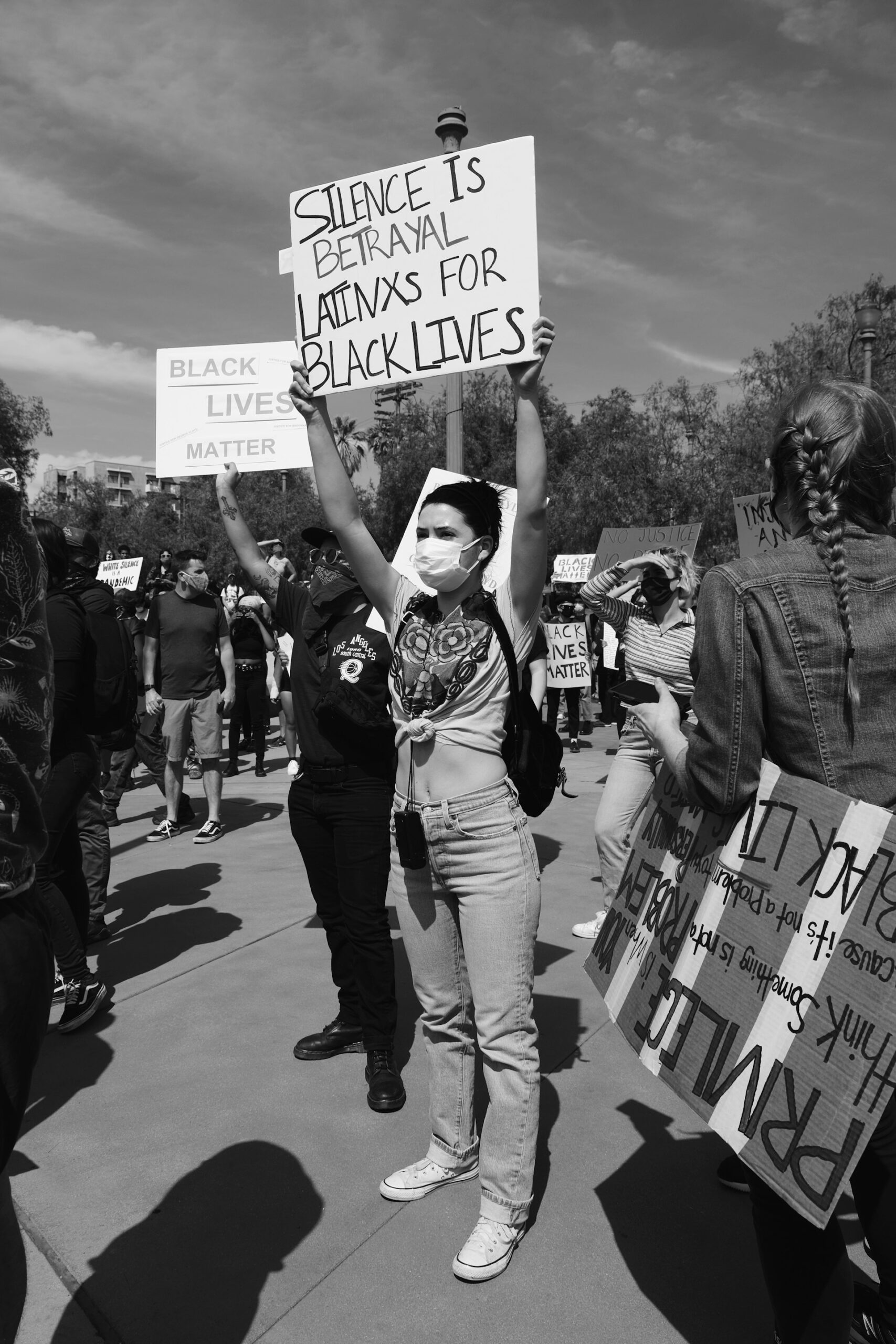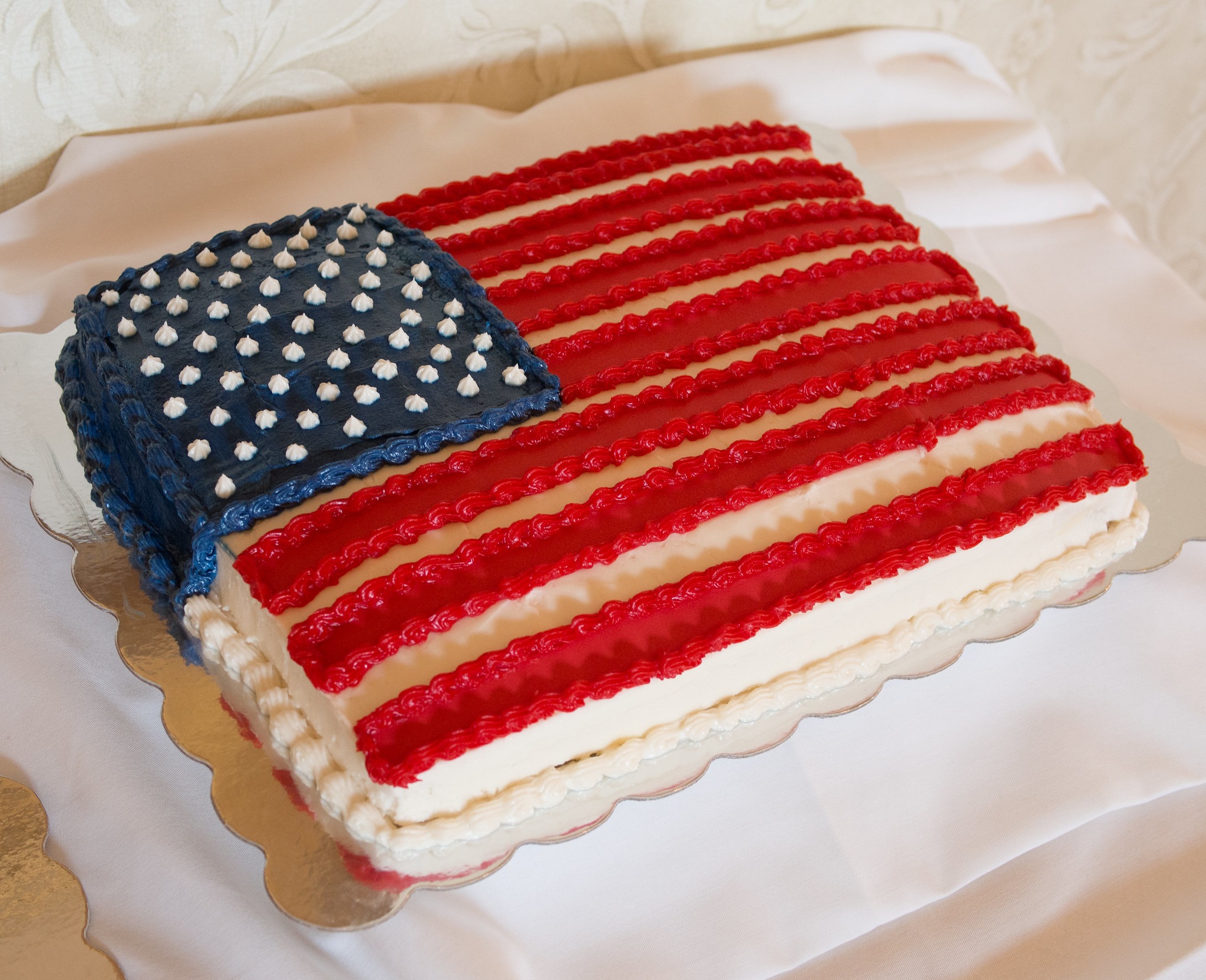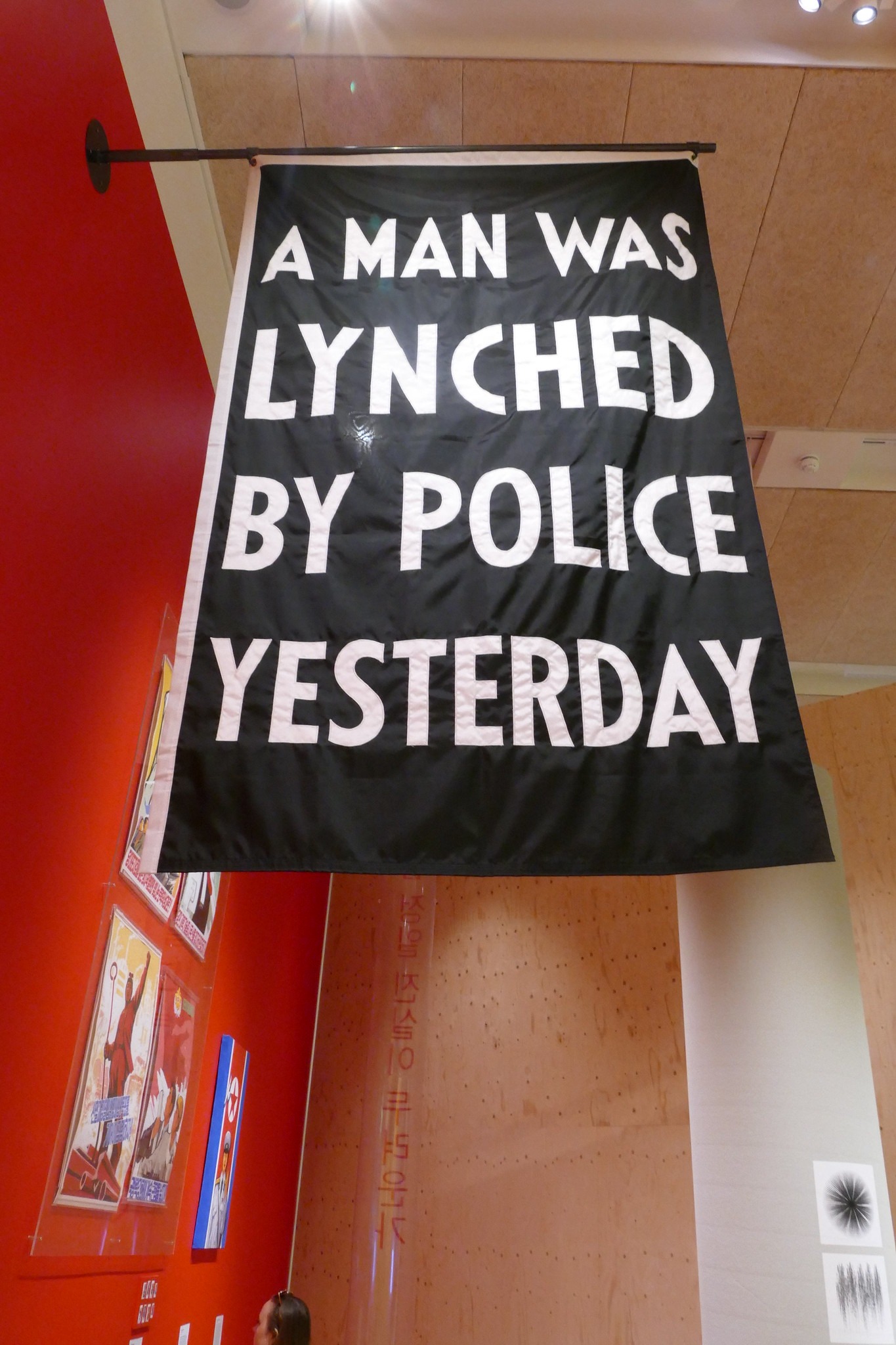The Performativity of Protest: A Cynic’s Guide

By Lisa Yin Zhang
Staff Writer
9/6/2020

George Floyd protest in Miami, 6th June 2020 (Picture Credit: Mike Shaheen)
Two weeks ago, George Floyd slipped a cashier a counterfeit $20 bill. Less than 20 minutes later, he was dead. He was pinned to the ground by an officer’s knee for a now-notorious 8 minutes and 46 seconds. Before him, a 26-year-old EMT was killed, past midnight, in bed. Her name was Breonna Taylor. The police had the wrong house; the person they were looking for had been apprehended earlier that day. Before that there was 12-year-old Tamir Rice, shot for wielding a toy gun he was gifted only moments before. Eric Garner, who pleaded, 11 times, “I can’t breathe.” Philando Castile, shot with his four-year-old in tow. Sandra Bland, dead after a traffic stop. Trayvon Martin.
I could go on; it’d be hard to stop. Police brutality in this country has a long legacy, beginning with slave patrols in which White volunteers located, returned, punished, and lynched, slaves. Following the Civil War, as Jim Crow laws were passed to limit black Americans’ work, pay, travel, housing, and ability to vote, these vigilante organizations evolved into modern police departments, primarily to control former slaves and their descendants. “Early American police departments shared two primary characteristics,” wrote Eric Potter, a scholar at the Eastern Kentucky University School of Justice Studies. “They were notoriously corrupt and flagrantly brutal.” A hundred years later, the civil rights movement — also sparked by police brutality and race-related oppression — was suppressed by police through brute force (it was, at the same time, also wildly successful). Today, policing and mass incarceration serves as “the new Jim Crow,” with African Americans incarcerated at five times the rate of White Americans. They are 2.5x more likely to be killed by the police even as they are 1.3x as likely to be unarmed.
There is a vast and long-standing culture of violence and complicity within American police departments that will be difficult to fix. Witness a police officer in Buffalo — purportedly one of the better departments in the country — shoving a 75-year old man; witness a dozen officers walking past the wounded man (one stopping another from kneeling to check on him), the mayor and department lying about it, saying he “tripped” and “fell,” the entire 57-man squadron resigning in protest of their treatment over the event. The bureaucracy of modern life — the regimentation of government into branches, departments, offices, the ranked positions, the endless paperwork — produces an illusion of civility, but a fundamental contract has been broken. This goes back to the founding principles of this country, to Locke: we enter a social contract wherein we cede some of our freedoms (keyword: some of) in exchange for state protection. Tax-funded police in this country, who are meant to serve and protect, are instead using unjustifiable, often lethal, force against their own people.
So what should we do? The Black Lives Matter site lists a number of petitions and fundraisers for families of victims (don’t donate through change.org, though — they take a cut). Find a vast array of organizations to contribute to compiled here. Post on your social media; email your local representative (find them here, if you’re in the US); read up; agitate your friends. Go out (with mask) and protest. It’s not all meaningless posturing — already, Eric Garcetti, mayor of Los Angeles, pledged to make cuts of up to $150 million to the police budget and reinvest those funds in black communities. Between my beginning to write this article and my submitting it, the mayor of New York City committed to moving some funds from police departments to youth and community services (details pending — keep pressing). Minneapolis, where George Floyd (and a number of other black citizens) was killed, banned the use of the chokehold and stranglehold. But all of this doesn’t go far enough — it’s untenable that chokeholds haven’t already been blanket banned across the country already. The history of this country has shown that violent protests change politics. When a social contract is violated by one party, what keeps the other from upholding it? Dragging policing into the 20th century is a start – not the end.
That’s it. This is not complicated. You can stop reading. That’s all you really need to know.
***
I found out about the death of George Floyd through my Reddit feed; I’m ashamed to say, I scrolled right past. The night before, I had watched a video of a White woman calling the police on a black bird-watcher. A few days before, I had read about the killing of Breonna Taylor. I was tired of outrage — of seeing outrage, of feeling it. (At the same time, I wonder, was I really “outraged”?)
A number of my friends went to the first protests around New York City. One of them, a native Upper West Sider, white, wealthy, went, posted about it on Instagram — I rolled my eyes. “Of course he did,” I said. Another went, wielding a sign reading “All Cops Are Bad.” As the week progressed, my Twitter feed was overtaken, my Instagram crowded, my Facebook feed clogged. I’m from one of the most liberal cities in America; I attended a college teeming with what a certain spectrum of the population would deem “snowflake liberals.” People I follow have been posting about police brutality for long before George Floyd was killed. But this time was different. People I’ve never seen post anything related to activism were suddenly agitating for donations for bail funds, driving out to supply granola bars and water bottles. My brother texted me, telling me to donate. My dad, for god’s sake, forwarded me an email on the interrelated plight of Asian Americans and African Americans. The mood has noticeably shifted.
A number of my friends went to the first protests around New York City. One of them, a native Upper West Sider, white, wealthy, went, posted about it on Instagram — I rolled my eyes. “Of course he did,” I said.
You could call me a cynic. It would be the least generous reading, but it wouldn’t be untrue. I do my homework; I pride myself on it. When I open my mouth, I’m usually confident that I know what I’m talking about with some fluency. I rarely (but still do, sometimes) posture: do something for the effect of receiving praise, or of having someone think better of me. I’ve avoided social media for most of my life; now that I’ve joined, I lurk, but almost never post. My best, and worst, trait is a commitment to “sincerity,” whatever that means. At its best, that means behaving in ways that are uncomfortable but morally correct: emailing a more senior writer the ways in which I believe their views to be prejudiced; agitating, at risk to my job, to be paid for an orientation I was legally required to be paid for; remaining seated, embarrassed and indignant, during a standing ovation for a speaker I didn’t agree with. It also means, unfortunately, bearing a skepticism I very often regret: calling out friends when they’re technically incorrect even as their heart is in the right place; immediately, it seems, assuming the worst intentions of people; and now, seeing others protesting in ways I think to be performative.
What explains my immediate skepticism toward, as one example, my friend’s “All Cops Are Bad” sign? I knew what answers I wanted to give myself: that they were jumping on this moment because it suddenly became cool to do so — where were they before? (Here, a logical contradiction presents itself as well: if I believe I could have held those views without others necessarily noticing, then why couldn’t they as well?) That they chose that slogan because it sounds cool and not because they know what it means.[1] That as a non-vulnerable demographic, they were possibly instigating violence they likely wouldn’t bear the brunt of. But one cannot ever truly know somebody else’s intentions. Whether I happened to be right or wrong, a degree of it was certainly projection: had I made that sign, I would be self-conscious of being, or perceived as being, somebody who did that only for the gesture and not for its substance.
[1] The slogan “All Cops Are Bad” — as I’ve recently learned — is a direct response to the protest “not all cops use unjustifiable force,” “not all cops kill,” essentially any of the anti-police-protest-protests that begin “Not all cops…” It argues that not all police officers use justifiable force, but all police officers participate in a negative culture of policing solely through being police officers. See the Buffalo example again: a cop is bad not just for pushing a 75-year-old man to the ground, but for walking past a 75-year-old man on the ground.

George Floyd protest, Minneapolis, 26th May 2020 (Fibonacci Blue)
In the past week or so alone, I’ve changed my mind. Insincerity is certainly dangerous — see, for instance, the black squares phenomenon, in which people tagging empty posts #BLACKLIVESMATTER on Instagram, purportedly to demonstrate their involvement with the movement, caused the hashtag to be inundated with blank squares, obscuring valuable information about protests. But it can also be quite valuable. I’m thinking back to the shift toward LGBTQ rights, for instance, which occurred within my own lifetime. Sometime when I was in middle school or high school, it became quite suddenly cool to care about gay rights; kids wore buttons to school. How many of those same kids were using slurs against gay people not long before? In that case, at least, it seems that people were being peer-pressured toward good ends. First a society acts a certain way; then it is that way. Perhaps a similar thing is happening now.

George Floyd protest in Los Angeles
Of course, if people can be peer-pressured into caring about gay rights, or black lives, couldn’t they just as easily be peer-pressured into, say, Trumpism? Fascism? Yes — clearly. A kind of game theory is taking place: how do you act, when you don’t know how others are going to act? The only way forward, it seems to me, is to be fully, sincerely honest with oneself — a continual and often self-flagellating process of holding one’s beliefs, reviewing the validity of those beliefs, feeling shame over holding what now seems clearly to be incorrect beliefs, and then holding new beliefs, and repeat, ad infinitum — while acknowledging, and possibly allowing, the possibility of everyone else’s insincerity. Who cares whether I stood or sat during an ovation? Only I truly care: I can sit with myself, or I can’t.
For me personally, I had to review the belief that simply being an advocate in my daily life — calling out prejudice where I saw it in others — was enough, even without donating money, nor writing my elected officials, nor posting on social media. Now, I don’t think that’s enough. For that, I have to credit the performativity of social media.
***
There’s an Onion headline that’s always stuck with me. It reads: “Not knowing what else to do, Woman Bakes American-Flag Cake.” It continues:
“Feeling helpless in the wake of the horrible Sept. 11 terrorist attacks that killed thousands, Christine Pearson baked a cake and decorated it like an American flag Monday.
“‘I had to do something to force myself away from the TV,’ said Pearson, 33, carefully laying rows of strawberry slices on the white-fudge-frosting-covered cake. ‘All those people. Those poor people. I don’t know what else to do.’…
“Having already donated blood, mailed a check to the Red Cross, and sent a letter of thanks to the New York Fire Department, Pearson wandered aimlessly from room in her apartment when the idea of creating the confectionery stars and stripes came to her.”

Picture Credit: Eugene Kim
I’ve donated; I’ve emailed my representatives; I’ve agitated people directly and through social media. And yes, I’ve found myself wandering aimlessly from room to room. The Onion, a satirical newspaper, is gently poking fun at a woman who, not knowing what else to do, performs an ostensibly useless gesture. But could that cake have worth?
I’m trying to answer, through a circuitous route, a question I have not been able to stop asking myself, that I should not stop asking myself: Why do I write in these times? Why do I make art? Why do I think about art? Could I do something better instead?
The desire for sincerity that threads through protest threads also, if not more so, through art. A friend of mine, a musician, released a song the Thursday after George Floyd’s killing. He had been planning the release for weeks; working on it for months. It was bad timing. There were so many killings; how could he — any of us — have known that this would be the straw that broke the camel’s back? On Saturday, he departed for a protest, biking a hundred and twenty blocks south and then marching twice that distance around lower Manhattan. He came back around midnight, dripping with sweat, feet blistered and bleeding. Still he wondered aloud to me, would he be excoriated for the timing?
Art-making in a crisis seems like the ultimate act of insincerity. When Greta Thunberg delivered her landmark speech on the climate crisis, a museum coworker said to me, What are we doing? I could ask that of myself right now. What are we doing?
As with the cake, part of the perceived insincerity of art-making in times of crisis is the presumed “uselessness” of art: it provides no utility. This is true even in so-called “normal times”: Art does not feed, nor clothe, nor shelter. Of course, a lot of things in our modern capitalist system don’t. How many of you could explain, non-abstractly, what Goldman Sachs really contributes to society? But art’s lack of tangible effect is doubly damning in a crisis. In art-making, you’re not contributing money to a cause. Your work is likely not seen by nearly the same number of people as even the most shoddily-constructed tweet or lazy Facebook post. At the same time, what difference exactly did, for instance, my contribution of $20 to the National Association for the Advancement of Colored People (NAACP) defense fund do? What if that $20 was spent on Starbucks lattes for their interns? Is my contribution measured by the marginal difference in productivity by those interns? Of course, that’s not even how capital works anymore — it’s impossible to track my $20 as it dissolves into the NAACP’s pool, which is siphoned off at the same time that it is (hopefully) refilled. I have no idea where my money went, what my impact is.
The perceived insincerity of art-making in times of crisis is the presumed “uselessness” of art: it provides no utility.
Still another is the guiltiness of pleasure. Work should not be pleasurable; it should be grueling. If art-making induces pleasure, it follows that it is not work; Q.E.D.
Let me be honest: There’s nothing I love more than the craft of putting together a good sentence, putting a couple good sentences together to make a good paragraph. I mean that sincerely. I feel incredibly lucky to be paid to educate myself on topics I wish I knew more about. At the same time, whereas a merely moral person would take out their own time to do exactly what I have done — read up on police brutality, its ties to systemic slavery and racism, the most effective ways to contribute, performative allyship on social media, etc, etc, — I can mete out a rate to myself for doing so: 10 hours of research and 10 hours of writing works out to $15/hr, my state minimum wage and a rate I can currently justify working at. Can one be moral if there is reward on the line?
This all easily spins off into nihilism: if you can’t be sure that anything you do is really making a difference, why do anything? How can one make art in times when it feels like more urgent issues are on the line? If you are compensated to make that art, is it really pure?
Remember the mantra: you can only do what you sincerely believe is right.
Here’s what I think: the purist vision of an artist as one who slaves outside of the framework of capitalism, driven only by their love of the craft, is a myth. If some of the greatest artists didn’t have patrons, they wouldn’t have made art. There are certainly great artists who never got to make art because they couldn’t live otherwise. I — a self-described artist, art historian, art critic, writer — believe in art in all of its forms, among them writing, to make a difference. I believe that the prospect of being paid to write this article gave me the opportunity to meditate deeply on this issue, and share those ruminations with you, a readership that is diverse and who might even disagree.
But again, I can’t really know for sure how many of you clicked on one of the links I posted, signed your name, donated money, or spoke to someone else about this issue directly because of me. And I can’t know how much impact it had, even if you did. I can only know that I did what I thought was right.
All this ran through my mind while I was making my flag.
It’s a copy of a 2016 artwork by the artist Dread Scott (named after Dred Scott, the enslaved man who sued for his freedom), which is itself a copy of a flag that hung outside of the NAACP for eighteen years, before its landlord forced its removal. It read: “A man was lynched yesterday.”
Dread Scott’s version of the flag inserts an addendum. It reads, “A man was lynched by police yesterday.” Two institutions own copies: Jack Shainman Gallery, in the Chelsea district of New York, and the Whitney Museum of American Art, not far from there. Jack Shainman flew the flag for some time before its landlord ordered its removal — 80 years later, it was still too controversial to be shown. During these protests, neither of the two institutions have shown it, according to Dread Scott himself, even as they’ve issued rather bland statements of support, even as he’s stated that he’d like them to show it.

Dread Scott’s flag in the Design Museum, London (Picture Credit Loz Pycock)
I don’t think that’s right. I think it should be shown. I think it — the work itself, and the role of art in protest — is important. So I made my own. It hangs outside my window as I write; let’s see if my landlord allows it.
Its making was quite insincere, as far as “pure” art goes. First, of all, it’s a copy of another artist’s work, a no-no in high art.
Second, it’s visibly amateurish. I typed, “how to hem something by hand” into YouTube, clicked, “How to Hand Sew: Slip Stitch & Blind Hem.” A voice said, brightly: “Cut the thread, and tie a knot.” I Googled, “how to tie a sewing knot.”
This is stupid, I thought. I have no idea what I’m doing. I’m terrible at this. This is a really stupid project.
I set some ground rules for the work.
Only materials I already had in the house. The tarp was a scrap of black fabric my boyfriend had left over from soundproofing. The letters were made from a white T-shirt from my alma mater.
There would be no distracting myself while making it: no music, no TV, only my mind wandering over the act, the message, the work. Many times it wandered past the act. Many times it wandered into bad metaphor, poor thinking: I thought about the violence of the act of pulling a needle through cloth, of pricking my fingers, then understood it to be more coincident than analogue.
Multiple times, I had to stop, humiliated, incredulous at the futility of this gesture, even as someone who purports to believe in art, especially as someone who believes in art.
I thought about the word “lynch,” flinching at its meaning, my use of it, whether I had a right to it. I Wikipedia’d it. An extrajudicial killing. Thus, the statement presented a paradox that itself suggested a conclusion: if the police, a judicial body (in one definition), lynched a man, an extrajudicial act, then it follows that the legal sanctioning of the act, in the form of no or low-level charges filed against the officers, no indictment, is incorrect. It suggests a disconnect between legality and morality. Yes, I thought. A man was lynched by police yesterday.
I wanted to make something that would last. That I could unfurl each time it happened, inevitably, again, becoming more damning with each repetition. I could hear the faint echo of insincerity. I recognized I sounded like someone talking about designing a house: I wanted a sundeck, I wanted a butcher’s block countertop, I wanted a pool, I wanted a…
Who knows how many people walking by this city block will look to the fourth floor window? Who knows how many of them would be moved to do something about its message? Maybe it really was only for myself. A personal totem. If nobody looked at it, I would. Is that really enough?
I poked the needle through the fabric – far off the mark. Tried again. Too far. Again. Closer. Again. Pulled the needle through. Again.
